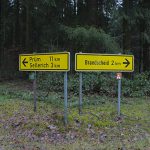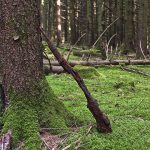Missing in action at Dausfeld
I believe it was 2013 when I first came into contact with Jerry Senear, son of Pfc. Orvis Senear who was killed in action on February 28th, 1945. Jerry wanted to learn more about the battles his father participated in before he was killed. We didn’t know anything more than that his dad served in I Company, 22nd Infantry Regiment and that he was killed in action in or near Dausfeld. A quest to learn more about the events that occurred in this tiny hamlet near Prüm began.
After consulting the book “Die Woche der Entscheidung” by Klaus Ritter, occupant of Weinsheim we learned more about the battle. Although at that time Dausfeld only consisted of a handful of houses, this strategic village was of great importance to the Americans who sought to advance from Prüm towards the Kyll river as soon as possible. In only a day the battle for the village was over, but it had cost the American and German forces dearly.
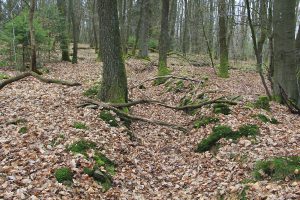
The tiny hamlet of Dausfeld lays just northeast of Prüm in the valley directly along the Prüm river. By mid-February the Americans had seized the city of Prüm and the wooded terrain to the north, called “Tettenbusch”. Dausfeld however stayed in German hands. The strategic purpose of this village was clear for both parties: there Dausfeld served as a gateway to the open plains directly east of town, which reached as far as Büdesheim and Schwirzheim. Also, the possession of the Prüm-Büdesheim road would allow the American forces a swift advance towards Gerolstein and the Kyll river. Therefore, it was important for the Americans to seize Dausfeld as soon as possible when the long-expected attack began. The Germans aware of the situation put an effort in building strong fortifications in and near the village. The houses were fortified, fields were mined and on the dominating high ground north (Dausfelder Hardt, 537) and south (Hünert, 551), trenches were dug. Responsible for the defense of Dausfeld was Oberleutnant Sniers, holder of the Knights Cross and commander of the 3rd Battalion, 15th Fallschirmjäger-Regiment.
On the other side, the 3rd Battalion of the 22nd US Infantry Regiment, who occupied the Tettenbusch area, was appointed to capture the village in the early morning of February 28th as the large-scale attack over the Prüm river began. As the men left their positions in the woods north of Prüm, they descended the heights in the area of Wolfsschlucht around 0515h. While it was still dark, L and I Company crossed the river at the Dausfelder Mühle (mill) at the bottom of the valley. Immediately the two companies were directed to their objectives. L Company was ordered to seize the hill of Dausfelder Hardt, and I Company was to seize the village itself. While the men of L Company entered the woods of Dausfelder Hardt they ran into a strong trench system occupied by the 3rd Battalion of the 15th Fallschirmjäger-Regiment. Although a large part of the enemy soldiers were only 17 to 18 years old and lacking sufficient training, their resistance was fanatical. It took the men of L Company more than four hours to finally throw the Germans out of their positions.
The two images below are quite extraordinary. The first picture shows the paybook of Günther Adler, a 17-year-old Fallschirmjäger who served in the 10th Company and who was captured near Dausfeld. The second image is a US press photo taken on February 28th at the Dausfelder Mühle which shows German prisoners with their guards ducking for cover behind a M10 tank destroyer while Germans are shelling the area. The second man from the right is again Günther Adler.
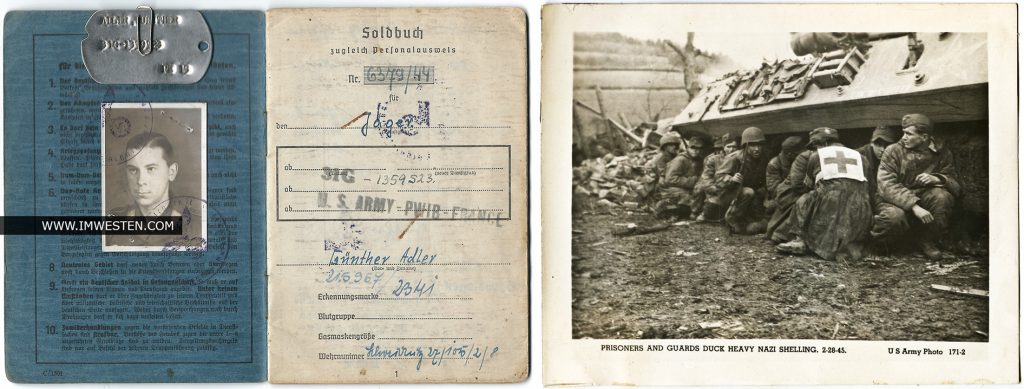
I Company however had a harder nut to crack. After L Company entered the cover of the Dausfelder Hardt woods to reach their objective, I Company had to take its objective over open terrain without any cover. The company under the command of Captain Tom Reid left the Dausfelder Mühle area at daybreak and moved towards the village itself. The men immediately ran into heavily defended German positions. A reinforced squad who was sent along the Hermespand-Dausfeld road was completely wiped out, and other attempts to seize Dausfeld over the open fields proved to be suicidal. The Germans on the Hünert hill were in such good positions that they could oversee and fire upon every movement down in the valley. After several futile attempts to capture the village it was obvious that it wasn’t possible without the support of armor. However, the tanks designated to attack Dausfeld were held up in the vicinity of Prüm as there all bridges over the river had been blown by the enemy. Engineers desperately tried to finish a Bailey bridge so the tanks could cross, however artillery and sniper fire prevented the engineers from finishing the job. At noon, some impatient tanks found a shallow spot to cross the river and from the direction of Hermespand a handful of tanks originally attached to the 8th Regiment were ordered to turn around and come to the aid of the 22nd Regiment.
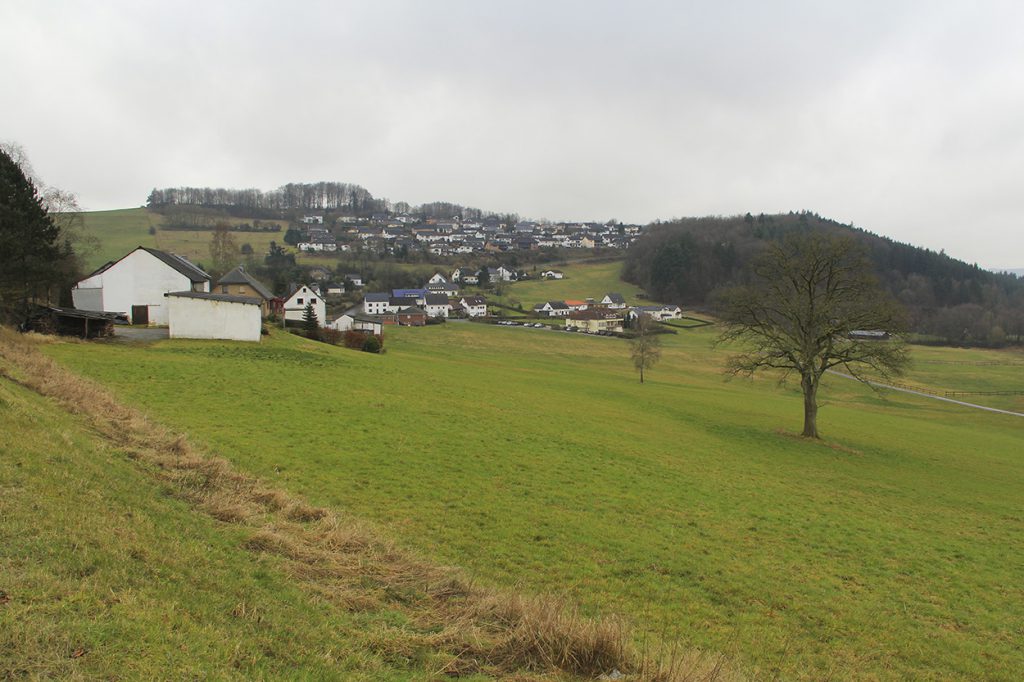
With the men of I Company now supported by armor, Dausfeld could be attacked from two directions. For the first time the men were able to reach and capture the first house in Dausfeld, positioned along the Hermespand road. It was here that 14 German prisoners were taken. Four Americans who were captured earlier that day and were held captive in the same building cried from relief when they were freed by their comrades. After a foothold was established in the village, the Americans ordered one of the young German prisoners to walk down to the part still held by the enemy and persuade them to surrender. Later that particular German soldier was found lying dead in the street, executed. Around afternoon the German resistance in the village still wasn’t broken. The remaining houses occupied by the Germans were bombarded by a hellish inferno from the supporting armor and after the 1st Battalion had seized the hill of Hünert the German resistance in the village finally broke. At 1550h a radio message from I Company to battalion reported that the village of Dausfeld was finally taken. I Company had lost 20 men, of which 10 were killed in action. Their names were:
Pfc. Geoffrey L. Bardwell
Pfc Ervin F. Bupp
Pfc. Frederick A. Burrel
Sgt. Wilburn Lewis
Sgt. Charles E. Osmun
Pfc. Fred W. Phillippe
Pfc. Milton P. Piner
Pfc. Donald L. Seger
Pfc. Orvis D. Senear
Tsg. Howard R. Willson
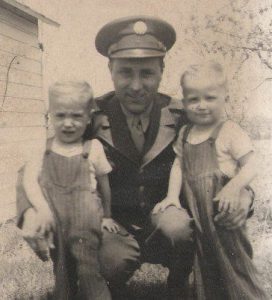
After Dausfeld was taken it took the 22nd Regiment several days before finally capturing Weinsheim, the next village. And it wasn’t until a week later that the Kyll river was reached. What the father of Jerry Senear concerns, the official report about the circumstances about his death mention the following: “On 28 Feb 45, while the weapons platoon in which he (Senear) was a mortar man, was advancing in the vic of Dausfeld, Germany, they by-passed some enemy forces, the enemy opened fire with small arms and ambushed the nearest man, who happened to be in the mortar section. Pfc Senear was struck by small arms fire and died instantly.” The cause of death was a gunshot wound to the left breast. Pfc. Orvis Senear was buried in the US Military Cemetery of Foy in Belgium, on March 5th, 1945.
Normally the story of a battle, for a certain village or a place ends here. However, the following research I have done tells more about the aftermath and human suffering as an outcome of such a battle, which is rarely written in historical books or mentioned in any other lecture.
In 2014 while walking through the forest in the immediate vicinity of Dausfeld, a friend of mine discovered a crater shaped hole in the woods. On a tree trunk next to this crater we encountered some rusty artifacts in the form of an US entrenching shovel, some shell casings and buttons. In the hole itself between the leaves, some decayed pieces of plastic sheets were discovered which appeared to have writing on them. Long story short, I put the stuff in a bag and took it home. When cleaning out the garage several months later, I again came across this bag and I took a closer look at the plastic sheets that we once discovered. I was amazed to read the following:
“Hier an diese Stelle wurden am Sontag den 24 März 1969 die letzten Reste der beiden gefallenen amerikanischen Soldaten des 22. Infanterie Regiments, 4. US Infanterie-Division; Ervin F. Bupp und Donald L. Seger gefunden. Beide sind am 28.2.1945 gefallen. RIP”

It goes without saying that I was interested to learn more about this discovery back in 1969. While the new highway (E29) was being built, members of the ordinance disposal team were cleaning the area for ammunition left behind during the battles in February – March 1945. And while the woods near Dausfeld were being searched, the remains of these two soldiers were discovered. How it was possible that the bodies of Pfc. Bupp and Seger were not recovered directly after the battle remains a mystery. The fact is that the shallow crater in the woods of Dausfeld was their resting place for almost 25 years. Although official reports could not give an definite answer about the circumstances of death before the discovery of the bodies, a fellow soldier of I Company witnessed that both Pfc. Bupp and Seger sought refuge in a shell crater and were killed by small arms fire after their squad of five man was ordered to eliminate a German machine gun position.
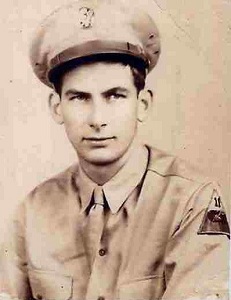
After looking into the other KIA (killed in action) cases of I Company at Dausfeld a sadder story came to light. It seemed that not only Pfc. Bupp and Seger were missing in action after the battle for the village was over, but also Osmun, Phillippe, Bardwell and Piner were initially listed as missing in action. The remains of Piner were eventually discovered in a field grave along the old road leading to Weinsheim back in 1946. Simultaneously, the remains of Bardwell and Phillippe were also recovered that year. Both remains of Pfc. Bardwell and Phillippe were found amidst a mass grave of German soldiers, who were also buried in Dausfeld after the battle. The reason that both US soldiers were buried between the German war dead was that both their remains were found by civilians. The civilians I guess simply didn’t make any distinction between the German or American dead, and saw it fit to bury them all together.
After three of the six missing of I Company were discovered in 1946, an investigation to find the remaining three was made in the late 1940s. The result was negative, and by 1951 official report was sent out to the next of kin that the remains of their loved ones were declared non recoverable. By 1954 however, a new re-investigation was made under Investigator / Sgt. John O. Smith. After talking to several mayors of the neighboring villages and learning about all the bodies that were recovered in the immediate area of Dausfeld after the war, the investigator finally spoke with Miss. Weisskopf, an occupant of the Dausfelder Mühle (mill). She declared the following interesting information:
In view of the fighting that was to be expected, she and other occupants of Dausfeld were evacuated from September 1944 till April 1945. After she returned back to the mill in the spring of 1945, she was walking to the village of Dausfeld together with her sister. When she was walking along the road, she saw two dead US soldiers near the edge of a trench in the nearby woods. In spite of the many mines planted in the entire area she and her sister walked up to the trench, where she saw one US soldier lying dead and the other one in front of him who had apparently tried to dress his wounds when he was hit himself. He was still wearing his steel helmet and both sisters had the impression of looking upon a monumental statue. Miss. Weisskopf then reported their find to the German authorities and when they returned to that spot a few days later they did not see the two bodies any longer and were of the opinion that they had been removed and buried in the mass grave together with the numerous other German soldiers found in the same vicinity.
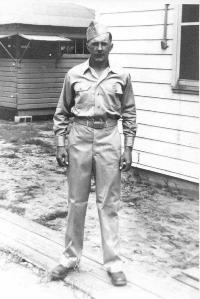
After telling this story in 1954 to Sgt. Smith, Miss. Weisskopf then accompanied the investigator to the nearby woods and pointed out the exact spot near a deep trench where she and her sister had seen the two dead US soldiers in April 1945. Upon looking into the trench, investigator John Smith noticed that a part of the trench had been filled up in this particular area and upon probing at both ends of the elevation in the trench, the typical soles of US army combat shoes became visible. Immediately, disinterring operations were commenced and the complete skeletal remains of two US soldiers were recovered. One of them was Sgt. Charles E. Osmun, his remains could be identified by means of identification tags and a golden ring bearing the initials CO. The recovery of the bodies proved to be a hazardous job because large amounts of ammunition, hand-grenades and weapons were found amidst the two remains.
It’s shocking that the person or persons who were ordered by the German authorities to recover the two deceased US soldiers simply threw the remains in the existing trench and covered them with dirt. It is highly plausible that this was also the case with the remains of Pfc. Bupp and Seger, with the only difference being that it would take another 15 years before their remains were found. A sad fact, especially when one knows that the father of Sgt. Osmun died only 11 days before the discovery of his missing son was made. The parents of Pfc. Bupp also died without knowing the fate of their son.
About the other remains found in the trench next to Sgt. Osmun, the identification is unknown to me. However, my guess is that they are the remains of Pfc. R. Haley, ASN 38694852, member of L Company. But further research has to confirm that.
Comments are closed.

